Hydrogen (H2) is the lightest and most abundant element in the universe. It is a colorless, odorless gas that is highly flammable and used extensively in various industrial applications.
Due to its unique properties, hydrogen plays a crucial role in the chemical, energy, and aerospace industries. However, its flammability and explosive potential require strict safety measures.
This article explores the safety concerns associated with H2, its applications, and essential best practices to ensure safe handling and usage.
Safety Concerns of Hydrogen
While hydrogen is not toxic, its physical properties pose significant safety risks. The primary concerns are related to its flammability, explosiveness, and the challenges of detection.
Flammability and Explosiveness
- Highly Flammable: H2 is highly flammable and can ignite in concentrations as low as 4% in air. It has a wide flammability range (4%-75%) and can combust explosively when mixed with air or oxygen.
- Low Ignition Energy: H2 requires very little energy to ignite, making it susceptible to ignition from static electricity, sparks, or heat.
- Invisible Flame: H2 burns with an almost invisible flame, making it difficult to detect a fire. This characteristic increases the risk of accidental burns and complicates firefighting efforts.
Detection and Dispersion
- Lightness and Dispersion: H2 is the lightest gas, allowing it to disperse rapidly in the atmosphere. While this can reduce the risk of accumulation, it also means that leaks can quickly spread and reach explosive concentrations.
- Odorless and Colorless: H2 is odorless and colorless, making it challenging to detect without specialized equipment. Leaks can occur unnoticed, posing significant safety risks.
Industries and Applications
Hydrogen is used across various industries, primarily due to its chemical and physical properties. Key applications include:
- Chemical Manufacturing: H2 is used as a reducing agent in numerous chemical reactions, including the production of ammonia, methanol, and other chemicals.
- Energy Production: H2 is a clean fuel source used in fuel cells to generate electricity. It is also being explored as a potential energy carrier in the transition to renewable energy.
- Aerospace and Aviation: H2 is used as a rocket propellant due to its high energy content and efficiency.
Best Practices for Hydrogen Safety
Given the potential hazards associated with H2, strict safety measures are essential to prevent accidents and ensure safe handling.
Monitoring and Detection
- Hydrogen Detection Systems: Reliable hydrogen detectors, such as the Accusafe or GasD 8000 by Interscan, are crucial for monitoring H2 levels in workplaces. These systems should be strategically placed in areas where hydrogen is stored or used and regularly calibrated for accuracy.
- Ventilation: Adequate ventilation systems are essential to disperse H2 gas and prevent the accumulation of explosive concentrations. Natural ventilation can be effective due to hydrogen’s lightness, but mechanical ventilation may also be necessary.
Personal Protective Equipment (PPE)
- Protective Clothing: While hydrogen does not pose direct health hazards through skin contact, workers should wear flame-resistant clothing to protect against potential fires and explosions.
- Eye Protection: Safety goggles or face shields should be worn to protect against debris or splashes in environments where hydrogen is used.
Emergency Response and Training
- Emergency Protocols: Clear emergency response plans should be established, including evacuation procedures, first aid measures, and fire suppression strategies. Given hydrogen’s unique fire characteristics, specific firefighting techniques and equipment are required.
- Training and Education: Regular training sessions on hydrogen safety, proper use of detection equipment, and emergency response actions are crucial. Workers should be familiar with the properties of hydrogen and understand the necessary precautions.
Lesser-Known Insights and Considerations
- Materials Compatibility: Hydrogen can cause embrittlement in certain metals, leading to potential failures in equipment and storage vessels. Using hydrogen-compatible materials is essential to prevent leaks and accidents.
- Environmental Impact: While hydrogen itself is not an environmental pollutant, its production can have environmental implications, depending on the method used. For instance, H2 produced from fossil fuels can contribute to greenhouse gas emissions.
Hydrogen is a versatile and essential element in various industries, but its flammability and potential explosiveness necessitate careful handling and rigorous safety protocols.
Understanding the safety concerns associated with hydrogen, implementing reliable detection systems, and adhering to best practices for safety are vital for preventing accidents and ensuring a safe working environment.
For more information on hydrogen gas detection systems and to request a quote for the Accusafe or GasD 8000 by Interscan, contact us today. Safeguard your workplace with advanced gas detection solutions tailored to your industry’s needs.


